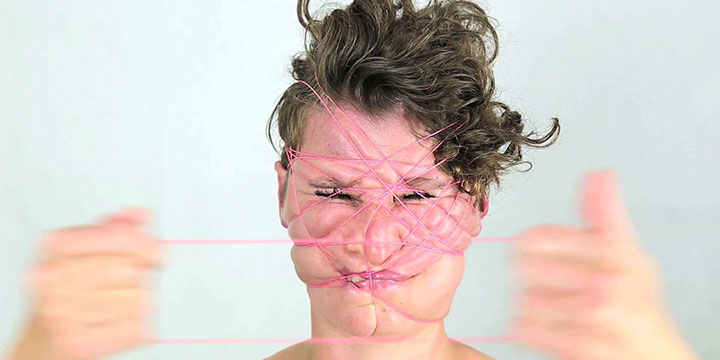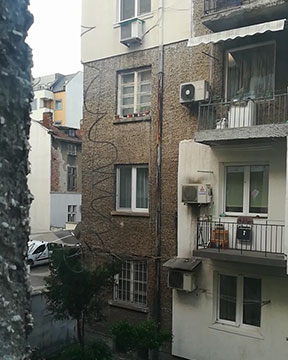Artists: Veneta Androva, Neno Belchev, Mitch Brezounek, Marina Genova, Nadezhda Oleg-Lyahova, Kalin Serapionov, Dimitar Shopov, Kamen Stoyanov, Samuil Stoyanov, Krassimir Terziev
Curators: Kalin Serapionov, Krassimir Terziev
I read somewhere a statement by Bulgarian gallerist Georgi Kolev saying that the beginning of video art in Bulgaria was a video recording of one of the first mass protests in Bulgaria on 14th December 1989 in front of the Parliament made by film director Evgeniy Mihaylov where the prime minister at the time Petar Mladenov (Bulgarian Communist Party) uttered the words 'bring in the tanks'[1]. I don’t know why this idea stuck in my head for a long time. Clearly the recording cannot be a work of art, it was never viewed as such either. But let’s imagine I’m deprived of common sense and I go with the idea that’s stuck in my head. No one ever found out whether those words really were said by Peter Mladenov. They were swamped by the surrounding noise and no expert analysis managed to make up for the poor quality. Notwithstanding the questionable character of this piece of evidence, the words stayed and were repeated in and out of context for decades. The video created a myth stimulating the imagination to produce not what is probable, but what is possible. And thus it may turn out to be the necessary myth of origin of video art in Bulgaria.
***
After decades of state monopoly on television and radio (two television channels and three national radio channels), in the 1990s we witnessed an inundation of cable operators broadcasting, with or without a license, all sorts of spam. 24-hour porn, martial arts films dating back two decades, action films and Latin American soap operas from the same period: a chaotic mix reaching unexpected heights with the apex of tele-magic – the psychic healer Kashpirovski[2], who would heal the entire nation live on air. This was the environment in which the moving image found the popular context from which to move forward as an art medium.
***
What we propose in this programme is a highly subjective and fragmented view on current practices in moving image in the Bulgarian art scene. We focused on practices that show affinity with speculative narratives - narratives that not just record what is in front of the cinematic eye, but also capture all the ghosts that are unreachable by the apparatus, thus projecting speculative views that intend not merely to describe, but to transform the world.
All works in the programme start not from a blank page, but from a directly lived experience that poses a problem. So they all stay close to the real, perceived from the personal position of the artist. But the artists are not content to figure all the elements that already shape the reality of the experienced situation, nor to reduce it to a chain of probabilities and calculations. On the contrary, their approach at work is to complicate the situation with all the possibilities that are not foreseen, with all the ghosts and monsters that are part of the picture but invisible from certain angles. In order to realise all the possibilities that shape reality the artists take on the angles of wild imagination, grotesque exaggeration, or poetic indetermination.
Yet what we witness is not merely artistic play. It is an outcome of certain ethical and political positions that reject the view that the world is a predetermined product of calculated probabilities, lately emerging as the apotheosis of the Capitalocene.
***
There are thick layers of context that each of the works in the selection contains that are necessary for a fruitful experience and interpretation. In 'Ear Cleaning' (2018) Veneta Androva lures the viewer to that inexplicable, comfortable shudder that ASMR videos create only to shake her/him the moment the language of the whispers is recognised to contain aggressive, paranoid, racist and homophobic hate-speech familiar in the distorted world of online discussions in the Bulgarian-language web. In the case of Neno Belchev’s 'My Heart is an Octopus...' (2016) it is the entire scene of post-socialist/neoliberal Bulgaria, the missing foundations of the artistic avant-garde in the 20th century history of the country and the schizophrenic relationships between generations, that is the backdrop of autobiographical fiction. 'A Made-up Story' (2014-2015) by Nadezhda Oleg-Lyahova paints ignored parts of the post-socialist landscape - the shrinking countryside full of abandoned villages with abandoned houses full of abandoned biographies exposed in found family albums - the result of massive emigration happening over the past 30 years. Samuil Stoyanov re-animates the dead stuffed animals in the collection of the Museum of Natural History in Sofia using the substance that moves matter - light ('National Museum of Natural History', 2014). History meets the future in a no-man's land of Istanbul peripheries - the site of the new gigantic Istanbul Airport - in the process of development during the film’s production. This is the site of 'New Istanbul Dream' (2017) by Kamen Stoyanov. Marina Genova’s 'New Comfort Zone' (2019) imagines and punctually visualises in a 3D model the AI-centric home of the near future, that could materialise in a very literal way Corbusier’s vision of the modern home as a machine. From the near future, speculation gets us teleported to the far-reaching film forecast 'Plovdiv Life Vest' (2017) by Dimitar Shopov. Shopov projected the 'eternal' city of Plovdiv in the year 2120 - a dystopian future in which the only humans surviving on the planet seek asylum in Plovdiv, where all machines became obsolete but there is still a machine that people cannot part with because it literally keeps the economy alive - the coffee machine. All these future scenarios are being suspended in Krassimir Terziev’s '[...] Suspended' (2020) - a horror movie without actors other than the camera and the spectator, shot during the lockdown caused by Covid-19 - a permanent present pregnant with expectations (good and bad). And touching on film genres - film noir was claiming everything begins with a fatal woman shaking the world out of balance. That sexist claim is ridiculed in 'A Blonde Woman in a Red Dress and Bright Lipstick is Talking on the Phone and Smoking a Cigarette' (2016) by Kalin Serapionov, in which the camera follows the 'model’s' movement and gestures. However, the viewer does not see the real image but its video scopes – the visualisation of the range of colours in the image. An important reminder that whatever the speculations or truth claims, a good amount of questioning of the apparatus that produced the image is required. In the contemporary art world the image is increasingly being produced not by the artist, but by the apparatus of the art industry. There are numerous manuals off-and-online, free or expensive, which promise to teach us how to break through the increasingly opaque surface of the art industry. Mitch Brezounek offers us precisely such a manual in his ‘How to Become the Best Artist in the World’ (2020), only this time with grotesque humour and hilarious B-movie aesthetics.
List of films/videos
Veneta Androva 'Ear Cleaning' 2018, animation, 18 min
Neno Belchev 'My Heart Is an Octopus or My Father on the Shore of the Black Sea' 2016, experimental autobiographical fiction, 93 min
Mitch Brezounek 'How to Become the Best Artist in the World' 2020, tutorial, 35 min
Marina Genova 'New Comfort Zone' 2019, animation, 3:44 min
Nadezhda Oleg-Lyahova 'A Made-up Story' 2014-2015, video, 13:17 min
Kalin Serapionov 'A Blonde Woman in a Red Dress and Bright Lipstick is Talking on the Phone and Smoking a Cigarette' 2016, video, 5:59 min
Kamen Stoyanov 'Havalimani – New Istanbul Dream' 2017, docufiction, 26:52 min
Samuil Stoyanov '10 min National Museum of Natural History' 2013, video, 10:20 min
Krassimir Terziev '[...] Suspended' 2020, experimental film, 8:38 min
Dimitar Shopov 'Plovdiv Life Vest' 2017, film forecast, 6:57 min
[1] On 14th December 1989 at one of the first large-scale oppositional rallies in front of Parliament aimed at changing the one-party political system, Petar Mladenov, Chairman of the State Council of the People’s Republic of Bulgaria at the time, said 'Better bring in the tanks' according to a video circulated by the opposition, which lead to the fall of the government and the beginning of the transition in Bulgaria. See: Wikipedia
[2] Anatoliy Kashpirovski is a para-psychotherapist who, following his success in the USSR, visited Bulgaria in the Vsyaka Nedelya [Every Sunday] show on Bulgarian National Television, conducting the so called 'telebridges' for remote mass healing.





































